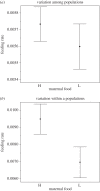Maternal food quantity affects offspring feeding rate in Daphnia magna
- PMID: 25030044
- PMCID: PMC4126628
- DOI: 10.1098/rsbl.2014.0356
Maternal food quantity affects offspring feeding rate in Daphnia magna
Abstract
Maternal effects have wide-ranging effects on life-history traits. Here, using the crustacean Daphnia magna, we document a new effect: maternal food quantity affects offspring feeding rate, with low quantities of food triggering mothers to produce slow-feeding offspring. Such a change in the rate of resource acquisition has broad implications for population growth or dynamics and for interactions with, for instance, predators and parasites. This maternal effect can also explain the previously puzzling situation that the offspring of well-fed mothers, despite being smaller, grow and reproduce better than the offspring of food-starved mothers. As an additional source of variation in resource acquisition, this maternal effect may also influence relationships between life-history traits, i.e. trade-offs, and thus constraints on adaptation. Maternal nutrition has long-lasting effects on health and particularly diet-related traits in humans; finding an effect of maternal nutrition on offspring feeding rate in Daphnia highlights the utility of this organism as a powerful experimental model for exploring the relationship between maternal diet and offspring fitness.
Keywords: maternal effects; population dynamics; resource acquisition; trade-offs; transgenerational effects.
© 2014 The Author(s) Published by the Royal Society. All rights reserved.
Figures


References
-
- Marshall DJ, Uller T. 2007. When is a maternal effect adaptive? Oikos 116, 1957–1963. (10.1111/j.2007.0030-1299.16203.x) - DOI
-
- Lampert W, Brendelberger H. 1996. Strategies of phenotypic low-food adaptation in Daphnia: filter screens, mesh sizes, and appendage beat rates. Limnol. Oceanogr. 41, 216–223. (10.4319/lo.1996.41.2.0216) - DOI
-
- Pop M. 1991. Mechanisms of the filtering area adaptation in Daphnia. Hydrobiologia 225, 169–176. (10.1007/BF00028394) - DOI
Publication types
MeSH terms
Grants and funding
LinkOut - more resources
Full Text Sources
Other Literature Sources
Medical
Research Materials

